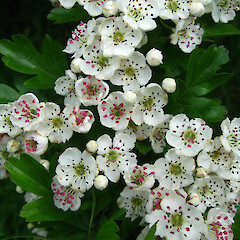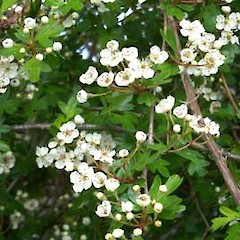Crataegus monogyna
Common name
hawthorn
Family
Rosaceae
Flora category
Vascular – Exotic
Structural class
Trees & Shrubs - Dicotyledons
NVS code
The National Vegetation Survey (NVS) Databank is a physical archive and electronic databank containing records of over 94,000 vegetation survey plots - including data from over 19,000 permanent plots. NVS maintains a standard set of species code abbreviations that correspond to standard scientific plant names from the Ngä Tipu o Aotearoa - New Zealand Plants database.
CRAMON
Conservation status
Not applicable
Habitat
Terrestrial. A plant of lowland and montane habitats. Plant occurs in sites with low to low/moderate fertility. A plant that grows in low forest, forest margins, scrub, hill country pasture, pasture, disturbed forest, waste places and roadsides.
Wetland plant indicator status rating
Information derived from the revised national wetland plant list prepared to assist councils in delineating and monitoring wetlands (Clarkson et al., 2021 Manaaki Whenua – Landcare Research Contract Report LC3975 for Hawke’s Bay Regional Council). The national plant list categorises plants by the extent to which they are found in wetlands and not ‘drylands’. The indicator status ratings are OBL (obligate wetland), FACW (facultative wetland), FAC (facultative), FACU (facultative upland), and UPL (obligate upland). If you have suggestions for the Wetland Indicator Status Rating, please contact: [Enable JavaScript to view protected content]
FACU: Facultative Upland
Occasionally is a hydrophyte but usually occurs in uplands (non-wetlands).
Detailed description
Shrub or small tree, up to 10m when mature, armed with axillary spines up to 12mm long, the longest spines associated with short flowering shoots; stems glabrous, smooth and reddish-brown when young but becoming grey when older. Leaves solitary on vigorous vegetative shoots but in fascicles on short shoots; petiole 5~25mm long, greenish, narrowly winged, grooved above; blade approx. deltoid to rhombic, 35~50 x 35~45mm, deeply lobed, glabrous, dark to mid green above, paler below with primary veins obvious; lobes 3~7, ascending, oblong, usually entire in lower half and sparingly and irregularly serrate near the acute apex; stipules of vegetative shoots reniform with prominently toothed margins, those of short shoots smaller and deciduous. Flowers many in flat corymbs subtended by small leafy acute bracts; bracts often larger and toothed on young stems; pedicels 5~11mm long, often bearing scattered, fine white hairs. Sepals greenish, finely pilose at least in lower part; lobes triangular to oblong, subacute, becoming reflexed. Petals broadly ovate to orbicular, 4~8mm diam., rounded to crenulate, spreading, usually white, rarely red-pink. Stamens < petals; filaments white or sometimes pale pink; anthers pink. Style usually 1. Fruit broadly oblong to subglobose, 7~11mm diam., dark red, shining, crowned by deflexed sepals; nutlets usually 1. (- Webb et. al., 1988)
Similar taxa
The plant is a deciduous shrub or small tree that can grow to 10m when mature (Webb et.al. 1988). The plant is armed with axillary spines that range from 12-20mm in length.
Flowering
August, September, October
Flower colours
Red/Pink, White
Fruiting
autumn; May onwards.
Life cycle
Perennial. Germination of seeds requires overwintering and is enhanced by passage through birds. A large amount of fruit is produced, with the percent and length of time viable unknown. Seed dispersal is through vertebrates (birds and possums).
Year naturalised
1899
Origin
Europe
Reason for introduction
Ornamental.
Tolerances
The plant is tolerant to drought and shade and highly tolerant to frost. The plant is intolerant to poor drainage.
Etymology
crataegus: From the Greek name krataigos ‘flowering thorn’, believed to be derived from kratos ‘strength’ alluding to the hardness of the wood











